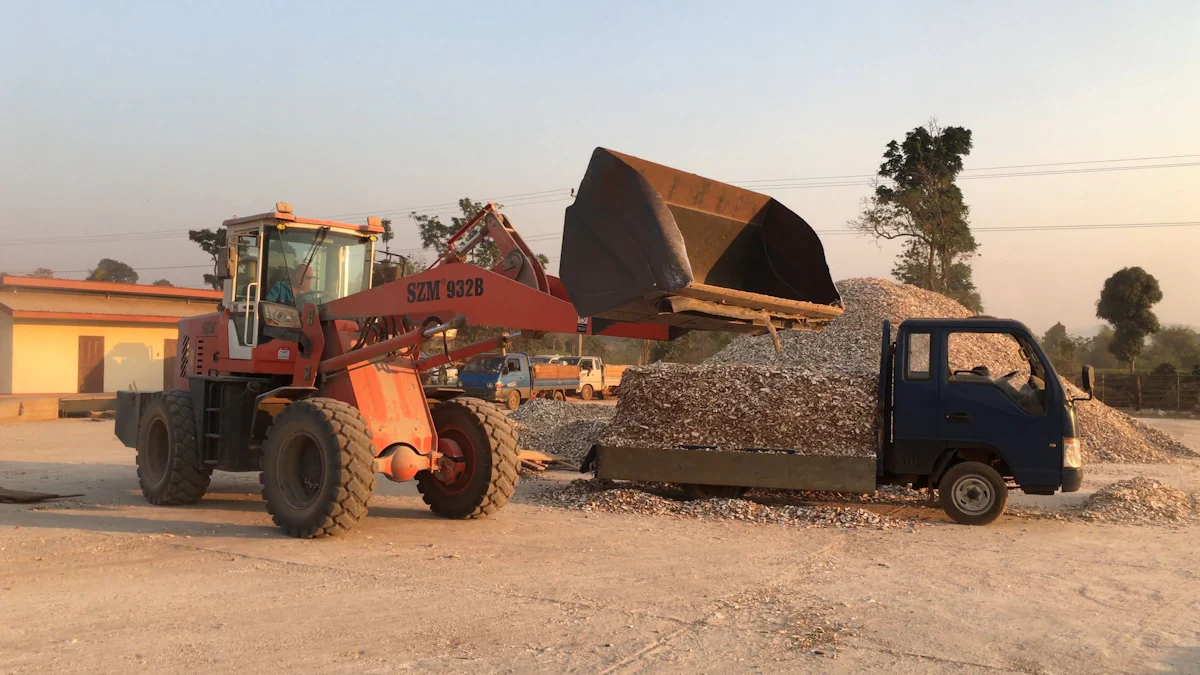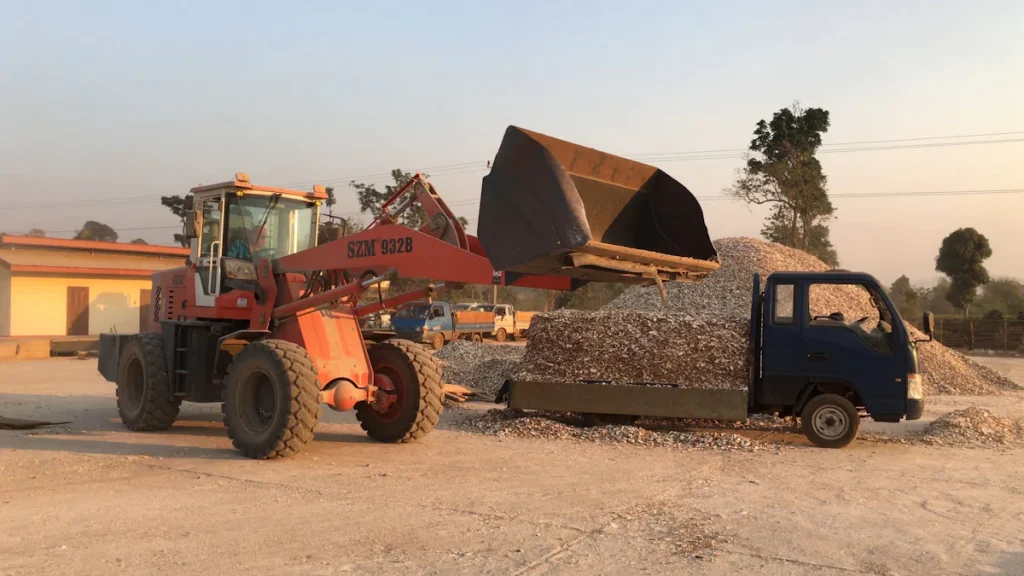
Diagrams play a crucial role in identifying excavator parts, making maintenance and repair tasks more efficient. By using an excavator parts diagram, you can easily pinpoint specific components, reducing the time spent on troubleshooting. This approach not only enhances your understanding of the machine’s structure but also aids in planning preventive maintenance. Identifying patterns in equipment performance through diagrams helps predict potential issues, ensuring optimal uptime. Embrace the power of diagrams to streamline your excavator maintenance process and keep your machinery running smoothly.
Key Takeaways
Utilize excavator parts diagrams to quickly identify components, reducing troubleshooting time and enhancing maintenance efficiency.
Familiarize yourself with serial and part numbers to ensure accurate ordering of replacement parts, preventing costly mistakes.
Understand exploded and cross-sectional views in diagrams to grasp the relationship between parts and diagnose issues effectively.
Learn common symbols and terms used in diagrams to improve your ability to interpret maintenance instructions and specifications.
Regularly review and cross-reference parts diagrams with the excavator’s manual to stay updated on new models and maintenance practices.
Seek expert assistance from professionals like YNF MACHINERY when facing challenges in parts identification or diagram interpretation.
Embrace the use of online resources for access to detailed diagrams and maintenance guides, enhancing your overall understanding of excavator operations.
Understanding Excavator Parts Diagrams

Excavator parts diagrams serve as essential tools for anyone involved in the maintenance or repair of these powerful machines. These diagrams provide a detailed visual representation of each component, making it easier for you to identify and locate specific parts. By familiarizing yourself with these diagrams, you can enhance your understanding of the excavator’s structure and functionality.
Key Components of Excavator Diagrams
When you examine an excavator parts diagram, you’ll notice several key components that are crucial for identifying parts accurately.
Serial Numbers
Serial numbers play a vital role in the identification process. They help you pinpoint the exact part your machine requires. Each serial number is unique to a specific component, allowing you to find the right replacement quickly. This precision is especially important when ordering parts online or consulting with a representative.
Part Numbers
Part numbers complement serial numbers by providing additional information about the component. They often include details such as the sales model and prefixes, which further assist in locating the correct part. By using both serial and part numbers, you can ensure that you order the exact component needed for your excavator.
Layout of Parts Diagrams
The layout of excavator parts diagrams is designed to offer a comprehensive view of the machine’s components. Understanding these layouts can significantly aid in the identification process.
Exploded Views
Exploded views are a common feature in parts diagrams. They display the components of the excavator in a disassembled state, allowing you to see how each part fits together. This perspective helps you understand the relationship between different components and simplifies the process of identifying and replacing parts.
Cross-Sectional Views
Cross-sectional views provide a different perspective by showing the internal structure of the excavator. These views are particularly useful for understanding the arrangement of components within the machine. By studying cross-sectional views, you can gain insights into the inner workings of the excavator, making it easier to diagnose issues and perform maintenance tasks.
By mastering the use of excavator parts diagrams, you can streamline your maintenance processes and ensure that your machinery operates efficiently. Whether you’re dealing with Cat parts diagrams or other brands, these diagrams are invaluable resources for anyone working with excavators.
Common Symbols and Terms in Excavator Diagrams
Understanding the common symbols and terms in excavator diagrams can greatly enhance your ability to maintain and repair these machines. These symbols and terms provide crucial information about the machine’s components and their specifications.
Recognizing Symbols
Symbols in excavator diagrams serve as visual shorthand for various specifications and limits. Recognizing these symbols is essential for accurate maintenance and repair.
Service Limits
Service limits indicate the maximum or minimum values that a component can safely operate within. You will often find these limits represented by specific symbols in the diagrams. Knowing these limits helps you ensure that each part functions correctly, preventing potential damage or failure.
Torque Specifications
Torque specifications are another critical aspect of excavator diagrams. These specifications tell you the exact amount of force needed to tighten bolts and other fasteners. Proper torque ensures that parts remain securely in place, reducing the risk of mechanical failure.
Understanding Technical Terms
Technical terms in excavator diagrams can sometimes seem daunting. However, understanding these terms is crucial for effective communication and maintenance.
Technical Jargon
Technical jargon refers to specialized language used within the industry. Familiarizing yourself with this jargon allows you to understand the diagrams more thoroughly. It also helps when discussing parts and repairs with professionals.
Abbreviations
Abbreviations are commonly used in excavator diagrams to save space and simplify complex terms. Learning these abbreviations will help you quickly identify parts and understand the diagram’s instructions.
By mastering these common symbols and terms, you can navigate excavator diagrams with confidence. This knowledge not only aids in maintenance but also enhances your overall understanding of the machine’s operation.
How to Read and Interpret Excavator Parts Diagrams
Understanding how to read and interpret excavator parts diagrams is crucial for effective maintenance and repair. These diagrams provide a detailed visual representation of the machine’s components, making it easier for you to identify and locate specific parts. By mastering the interpretation of these diagrams, you can enhance your ability to maintain your excavator efficiently.
Using Legends in Diagrams
Legends in parts diagrams serve as a guide to understanding the symbols and colors used throughout the diagram. They are essential for accurate interpretation.
Color Codes
Color codes in excavator parts diagrams help differentiate between various components and systems. Each color represents a specific part or function, allowing you to quickly identify the area of interest. For example, hydraulic systems might be highlighted in blue, while electrical components could be marked in red. Familiarizing yourself with these color codes will streamline the identification process.
Symbol Explanations
Symbols in parts diagrams act as shorthand for various specifications and instructions. The legend provides explanations for these symbols, ensuring you understand what each one represents. Recognizing these symbols is vital for accurate maintenance and repair, as they convey important information about the parts and their functions.
Annotations and Notes
Annotations and notes in parts diagrams offer additional insights and instructions that are crucial for proper maintenance.
Manufacturer’s Notes
Manufacturer’s notes often include important information about the parts and their specifications. These notes can provide guidance on installation procedures, compatibility, and other critical details. Paying attention to these notes ensures that you follow the manufacturer’s recommendations, which can prevent errors and enhance the longevity of your excavator.
Assembly Instructions
Assembly instructions in parts diagrams guide you through the process of putting components together. These instructions are essential for ensuring that parts are assembled correctly and function as intended. By following these instructions, you can avoid common mistakes and ensure that your excavator operates smoothly.
By learning to read and interpret excavator parts diagrams, you can significantly improve your maintenance processes. Whether you’re dealing with Cat parts diagrams or other brands, understanding these diagrams is invaluable for anyone working with excavators. This knowledge not only aids in maintenance but also enhances your overall understanding of the machine’s operation.
Practical Tips for Using Excavator Diagrams
Understanding how to effectively use excavator parts diagrams can greatly enhance your maintenance and repair tasks. Here are some practical tips to help you make the most of these valuable resources.
Regular Review of Diagrams
Regularly reviewing excavator parts diagrams is essential for staying updated with the latest models and ensuring accurate maintenance.
Keeping Updated with New Models
Manufacturers frequently release new excavator models with updated parts diagrams. To keep your knowledge current, regularly check for updates from the manufacturer. This practice ensures that you have the most accurate information when identifying parts for maintenance or repair. Staying informed about new models helps you anticipate changes in design and functionality, allowing you to adapt your maintenance strategies accordingly.
Cross-Referencing with Manuals
Cross-referencing parts diagrams with the excavator’s manual provides a comprehensive understanding of the machine’s components. The manual often contains detailed descriptions and specifications that complement the visual information in the diagrams. By using both resources together, you can ensure that you correctly identify parts and follow the recommended maintenance procedures. This approach minimizes errors and enhances the efficiency of your maintenance tasks.
Seeking Support from YNF Machinery
When you encounter challenges in identifying parts or interpreting diagrams, seeking support from experts can be invaluable.
Contacting YNF MACHINERY for Assistance
If you can’t find the parts you need or have questions about the diagrams, contacting YNF MACHINERY can provide the assistance you require. Their team of experts is available to help you identify the correct parts and offer guidance on maintenance procedures. By reaching out to them, you can benefit from their extensive knowledge and experience in the field of excavator parts.
Utilizing Online Resources
In addition to direct support, YNF MACHINERY offers a range of online resources to assist you in using parts diagrams effectively. Their website provides access to detailed diagrams, product specifications, and maintenance guides. These resources can help you understand the intricacies of your excavator and ensure that you perform maintenance tasks accurately. By leveraging these online tools, you can enhance your ability to maintain your machinery efficiently.
By following these practical tips, you can maximize the benefits of excavator parts diagrams and ensure that your machinery operates smoothly. Whether you’re dealing with new models or seeking expert support, these strategies will help you navigate the complexities of excavator maintenance with confidence.
Benefits of Accurate Excavator Part Identification
Accurate identification of excavator parts plays a pivotal role in maintaining the efficiency and longevity of your machinery. By understanding each component, you can ensure that your excavator operates smoothly and effectively.
Improved Maintenance Efficiency
Accurate part identification significantly enhances maintenance efficiency. When you know exactly which part needs attention, you can reduce downtime and ensure that your excavator arm, boom, stick, and bucket function optimally.
Reducing Downtime
Downtime can be costly. By accurately identifying parts, you can minimize the time your excavator spends out of operation. Quick identification allows for faster repairs, ensuring that your excavator arm and other components are back in action swiftly. This proactive approach helps maintain productivity and reduces the impact of unexpected breakdowns.
Ensuring Correct Part Replacement
Using the correct parts is crucial for the longevity of your excavator. Accurate identification ensures that you replace parts like the boom, stick, and bucket with the right components. This precision prevents further damage and maintains the integrity of your machinery. By ensuring correct part replacement, you enhance the reliability of your excavator and avoid potential issues that could arise from using incorrect parts.
Cost Savings
Accurate part identification also leads to significant cost savings. By knowing exactly what your excavator needs, you can avoid unnecessary expenses and extend the lifespan of your equipment.
Avoiding Incorrect Purchases
Incorrect purchases can be expensive. When you accurately identify parts, you eliminate the risk of buying the wrong components for your excavator arm, boom, or bucket. This precision saves you money and ensures that your investment in parts is well-spent. By avoiding incorrect purchases, you can allocate resources more efficiently and focus on maintaining your excavator’s performance.
Extending Equipment Lifespan
Proper maintenance and accurate part replacement extend the lifespan of your excavator. By identifying and replacing worn-out parts like the stick and bucket promptly, you prevent further damage and ensure that your machinery remains operational for longer. This approach not only saves money but also maximizes the return on your investment in the excavator.
Mastering the reading of excavator diagrams is essential for effective maintenance. These diagrams provide a clear visual guide to each component, helping you identify and address issues promptly. Regular practice in interpreting these diagrams will enhance your skills and confidence. Consulting with experts like YNF MACHINERY can further refine your understanding. Their expertise ensures you make informed decisions, extending the lifespan of your excavator. Embrace these resources to keep your machinery in top condition, ensuring efficient and reliable operation.
FAQ
What are some frequently asked questions about excavator parts and maintenance?
Excavators, essential for construction tasks like excavating and demolishing, consist of various parts. Each part plays a specific role in the machine’s performance. Understanding these roles helps you maintain the excavator effectively.
Why is an excavator parts diagram important?
An excavator parts diagram serves as a crucial tool for ordering replacement parts. It offers a detailed overview of all components, making it easier for you to identify and specify the exact parts needed for maintenance or repair.
How can I identify the correct part for my excavator?
To identify the correct part, use the serial and part numbers found on the excavator parts diagram. These numbers provide precise information about the component, ensuring you order the right part for your machine.
What should I do if I can’t find a part in the diagram?
If you can’t locate a part in the diagram, consult the manufacturer’s manual or contact a professional like YNF MACHINERY. They can assist you in identifying the correct part and provide guidance on maintenance procedures.
How often should I review my excavator parts diagram?
Regularly review your excavator parts diagram, especially when new models are released. Staying updated ensures you have the most accurate information for identifying parts and planning maintenance tasks.
Can I use online resources to help with parts identification?
Yes, online resources can be invaluable. Websites like YNF MACHINERY offer detailed diagrams, product specifications, and maintenance guides. These resources help you understand your excavator better and perform maintenance tasks accurately.
What are the benefits of using the correct parts for my excavator?
Using the correct parts ensures optimal performance and longevity of your excavator. It reduces downtime, prevents further damage, and maintains the integrity of your machinery, ultimately saving you money.
How do I ensure proper assembly of parts?
Follow the assembly instructions provided in the parts diagram. These instructions guide you through the process, ensuring that parts are assembled correctly and function as intended.
What role do symbols play in excavator diagrams?
Symbols in excavator diagrams provide visual shorthand for specifications and limits. Recognizing these symbols helps you perform accurate maintenance and repair, ensuring each part functions correctly.
How can I extend the lifespan of my excavator?
To extend your excavator’s lifespan, perform regular maintenance and replace worn-out parts promptly. Accurate identification and replacement of parts like the boom, stick, and bucket prevent further damage and ensure long-term operation.





